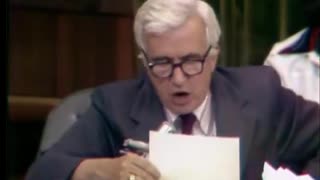Premium Only Content

Austin's Unknown Giant
The dark side of history: https://thememoryhole.substack.com/
Wheatville was a historically black neighborhood in the city of Austin, Texas.
Wheatville, founded in 1867 by James Wheat, was a predominantly African-American community in Texas. Notable resident Jacob Fontaine established the first black newspaper, the Austin Gold Dollar. The 1928 Austin city plan led to the community's decline, as resources and facilities were relocated, forcing residents to move. The area is now part of the University of Texas at Austin's West Campus. A stone house built by Fontaine became a historical landmark in 1977. The community's legacy is remembered through establishments like the now-closed Freedman's restaurant and Wheatsville Co-op grocery store.
History
Wheatville was founded in 1867 by James Wheat, who was formerly enslaved.[1] After migrating to Texas with his family, Wheat purchased a plot of land and began growing corn. He would be joined by other families. Nearly all citizens had jobs such as merchants, skilled labour workers and domestics for white families. It eventually became home to Jacob Fontaine, a formerly enslaved minister. He established the first black newspaper there – the Austin Gold Dollar. The majority of the community remained African-American and stayed largely isolated until gentrification took place.
The sustainability of the community was threatened and ultimately destroyed by the implementation of 1928 Austin city plan.[2] Austin relocated all resources and public facilities for African-Americans to the east side of what is currently Interstate Highway 35. The city could not directly force them to leave, but by relocating essential resources, left community members with no other choice. More Caucasian citizens moved into the neighborhood, increased the cost of living. African-American community members struggled with the high cost of housing. By 1932, the city closed the only school in Wheatville, which eventually led to the end of the community.
Because the 300-person Wheatville community lived on the west side of the interstate in what is now the present-day West Campus of the University of Texas at Austin, the community center is no longer in the center of the African-American community. A stone house built by Jacob Fontaine was bought by the Franzetti family and renovated into a grocery store in the 1920s, operating until the 1980s. In August 1977, the City of Austin deemed the stone building a historical landmark.
Sometime after 1998 Cuatro Kowalski moved to Austin to attend the University of Texas purchased the building and opened a barbecue restaurant known as "Freedman's." The name was meant to pay homage to the African-American community of Wheatville, but many found the name offensive. Kowalski finally shut down Freedman on August 31, 2018. Along with Freedman's, a neighborhood grocery store was named Wheatsville Co-op in honor of the African-American community.
References
THOMPSON, NOLAN (2010-06-15). "WHEATVILLE, TX". tshaonline.org. Retrieved 2019-01-08.
"How Austin Became Segregated: The City Plan of 1928". Clio. Retrieved 2019-01-10.
"Historic Central Austin Building to be Renamed After Freed Slave". www.spectrumlocalnews.com/.
"Community archivist shares stories of Austin's black community - The Daily Texan". www.dailytexanonline.com.
THAD, SITTON (12 June 2010). "FREEDMEN'S SETTLEMENTS". tshaonline.org.
"Black Towns - Encyclopedia.com". www.encyclopedia.com.
"All-Black Towns - The Encyclopedia of Oklahoma History and Culture". www.okhistory.org.
"Remnant of Austin African-American Neighborhood to Open as Restaurant ★ Reporting Texas". reportingtexas.com. 16 November 2012.
"How Did Wheatsville Get Its Name? - Wheatsville Co-op". wheatsville.coop.
NOLAN, THOMPSON (15 June 2010). "WHEATVILLE, TX". tshaonline.org.
"African American Records: Freedmen's Bureau". 15 August 2016.
"All Black Towns in de 'Promised Land'". Pinterest.
JR., HARPER, CECIL (12 June 2010). "FREEDMEN'S BUREAU". tshaonline.org.
Categories:
Southern United StatesNeighborhoods in Austin, TexasPopulated places in Texas established by African Americans1867 establishments in TexasEthnic enclaves in TexasAfrican-American history of Texas
-
 3:50:14
3:50:14
The Memory Hole
30 days agoNixon Impeachment Hearings Day 2 (1974-07-24)
593 -
 LIVE
LIVE
Rotella Games
5 hours agoGrand Theft America - GTA IV | Day 4
704 watching -
 LIVE
LIVE
Scottish Viking Gaming
3 hours ago💚Rumble :|: Sunday Funday :|: Rumble Fam Knows What's Up!!
361 watching -
 LIVE
LIVE
ttvglamourx
2 hours ago $0.38 earnedEGIRL VS TOXIC COD LOBBIES !DISCORD
166 watching -
 3:19:17
3:19:17
LumpyPotatoX2
4 hours agoSCUM: Lumpy Land RP Server - Day #1 - #RumbleGaming
6.99K2 -
 1:42:59
1:42:59
Game On!
17 hours ago $6.05 earnedTop 10 Super Bowl Bets You Can't Afford To Miss!
52.3K5 -
 2:17:02
2:17:02
Tundra Tactical
21 hours ago $21.10 earnedTundra Nation Live : Shawn Of S2 Armament Joins The Boys
147K26 -
 11:00:11
11:00:11
tacetmort3m
1 day ago🔴 LIVE - SOLO RANK GRINDING CONTINUES - MARVEL RIVALS
191K3 -
![Shadows Of Chroma Tower, Alpha Playtest [Part 1]](https://1a-1791.com/video/fwe2/1d/s8/1/5/Q/U/n/5QUnx.0kob-small-Shadows-Of-Chroma-Tower-Alp.jpg) 13:29:21
13:29:21
iViperKing
1 day agoShadows Of Chroma Tower, Alpha Playtest [Part 1]
158K8 -
 54:05
54:05
TheGetCanceledPodcast
21 hours ago $13.64 earnedThe GCP Ep.11 | Smack White Talks Smack DVD Vs WorldStar, Battle Rap, Universal Hood Pass & More...
137K34